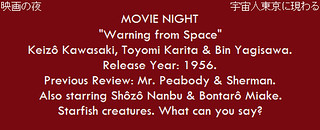
Review #1126: Warning from Space.
Cast:
Keizô Kawasaki (Dr. Toru Itsobe), Toyomi Karita (Hikari Aozora / Ginko), Bin Yagisawa (No. 2 Pairan), Shôzô Nanbu (The Elder Dr. Itsobe), Bontarô Miake (Dr. Kamura), Mieko Nagai (Taeko Kamura), Kiyoko Hirai (Mrs. Matsuda), and Isao Yamagata (Dr. Matsuda) Directed by Koji Shima.
Review:
Warning from Space (also known as Uchūjin Tokyo ni arawaru) is a film that is a science fiction tokusatsu (a term to describe a film that uses many special effects) that came after the popularity of Gojira (1954). It is loosely adapted from a novel by Gentaro Nakajima, with the creatures being designed by avant-garde arist Tarō Okamoto, which had a starfish resemblance with one eye. It was produced and distributed by Daiei Film, which produced films such as Rashomon and the Gamera film series prior to its merger with Kadokawa Pictures in 2002. In a decade that brought the first color feature for Japan with Carmen Comes Home (1951), this happens to be the first Japanese color science fiction film. I can't say that this film comes out a winner, but I will give it credit for occasional sparks of imagination. The sequences with the creatures (which contrary to the posters are human scale and not large) certainly lend themselves attention, since they stick out in their own way from usual films with creatures, having a weird but amusing look to them. Any time the aliens are on screen makes the film have some sort of energy and life. Actually, one other sequence is amusing, involving an alien trying to disguise herself as a human, complete with leaping ten feet in the air when playing tennis and materializing wherever she wants.
However, the film likes to focus more on its plot (much like another film that took influence from it - Gorath, released six years later), there is a certain feeling of boredom that levels in due to the resulting scenes not being particularly compelling. The cast don't do a terrible job with what they're given, with Yamagata being a fair standout, although this is more of a movie that strolls to its destinations. Nobody is too particularly over-the-top, not too underplayed, but it's the kind of performances that play to the sci-fi cliches without really giving too much life to the film. Oddly enough, this film has slipped into the public domain, which makes it readily available on the Internet. The version I watched was dubbed in English, which was produced at Titra Sound Studios by Jay H. Cipes and Edward Palmer. If one is curious to view the film, I would advise to try and fine a good quality print, as opposed to prints that have a washed out look (as is the case with some films in the public domain) that hurt the viewing experience since it is in color. The film as a whole has a decent look, but it isn't anything that shines over other sci-fi films of its ilk. However, it, along with other sci-fi films of its time had an influence on Stanley Kubrick, who made 2001: A Space Odyssey twelve years later. On the whole, this isn't a terrible experience, in part because of the effects that shine on occasion. At 87 minutes, it may move a sluggish kind of pace, but it may prove worth it for people looking for something to pass some time with sparks of curiosity.
Overall, I give it 5 out of 10 stars.

No comments:
Post a Comment